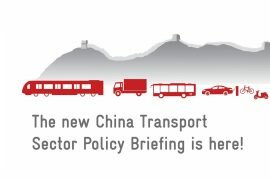China Transport Sector Policy Briefing – 2019, Issue 2
 The newest issue of our China Transport Sector Policy Briefing is here! The Sustainable Mobility Team at GIZ in China provides you with regular summaries of important policies in China’s transport sector.
The newest issue of our China Transport Sector Policy Briefing is here! The Sustainable Mobility Team at GIZ in China provides you with regular summaries of important policies in China’s transport sector.
Please click here to download: China Transport Sector Policy Briefing Issue 2 2019
World’s first EV energy consumption standards, stricter emissions standards, pollution control of diesel trucks, shift from road to rail
China has unveiled the world’s first technical standards on energy consumption of electric vehicles (EV). The national standards specify the energy consumption limits for different types of EVs, according to the State Administration for Market Regulation (SAMR) and the Standardization Administration of China (SAC). This standard is aiming to accelerate the process of implementing energy-saving technologies as well as to facilitate the reduction of energy consumption, in order to achieve energy-saving targets and to encourage a sustainable development of the EV industry. The standard is not binding but recommended by the authorities, with a scheduled ratification on 1 July 2019.
We see that the Jing-Jin-Ji Metropolitan Region (Beijing, Tianjin, Hebei) is strengthening its measures towards achieving the full implementation of China’s strictest vehicle emission standards (CHINA VIb). Take the expample of Tianjin: From 1 July 2019 on, Tianjin will no longer allow the selling and registering of light-duty vehicles which do not meet the CHINA VIb standard.
Hebei Province, where the sale of diesel or gasoline vehicles non-compliant with CHINA VIb has been forbidden since the start of this year, has now announced similarly comprehensive measures towards light-duty vehicles to take effect on 1 July 2019: Besides selling, the registration and re-registration of vehicles which do not comply with CHINA VIb will also be forbidden.
The city of Beijing focuses on heavy-duty vehicles which are registered in Beijing and powered with compressed natural gas (CNG) or liquefied natural gas (LNG) or which are used for public transport and sanitation. They must meet the national level CHINA VIb standard 4 years earlier – from 1 July 2019 onwards.
Standards is only one side of the coin. Another one is the shift from road to rail and waterways. Cleaner freight transportation and thus improved air quality is the theme in China’s transport sector today.
Shandong’s provincial government for example announced a plan to prevent and control pollution caused by diesel trucks on the one hand. By 2020, the province aims to improve the quality of diesel fuels, increase the number of clean diesel engines, decrease nitrogen oxides and particulate matter emissions, and strengthen quality control capacities. Furthermore, it aims to increase the proportion of NEVs used for public transport, sanitation, postal services, car rental, and light logistics in urban areas: NEVs shall account for 80% of those fleets by 2020. On the other hand, the province will promote the shift from road to rail, aiming to increase rail freight volume and promote green freight mechanisms.
Hunan Province launched an Implementation Scheme for adjusting its transport structure based on the national Three-Year Action Plan, which focuses on the shift from road to rail and waterway. The main objective of the implementation plan is to optimize the provincial railway and waterway transportation network. The plan targets an increase of railway transportation volume by 18% (7.55 million tons) and an increase of waterway transportation volume by 10% (3.95 million tons). Besides, multi-modal transportation volume shall see an annual increase by 20%. The achievement of the objectives is planned for 2020, with 2017 as the base year.





Comments are closed.